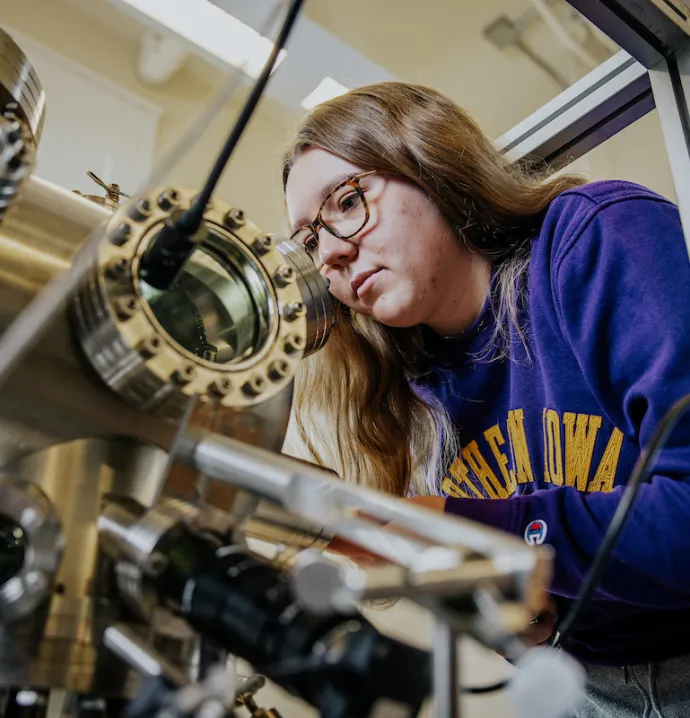Rising from the ashes
Rising from the ashes
If you walk around the University of Northern Iowa campus with the right kind of eyes, you can see signs of both an arboreal crisis and the beginning of a new chapter of UNI’s biodiversity.
The telltale markings are subtle - some bark discoloration here, a circular patch of dirt where a tree was recently uprooted there. They are the signs of the emerald ash borer, an invasive species that campus groundskeepers have been struggling with for more than a decade. The small beetle has decimated the ash trees on campus, but it has also opened a window for the planting of a wider variety of trees –hundreds of saplings that now dot the campus – that will boost the biodiversity for years to come.
The emerald ash borer has caused the campus groundskeepers to remove around 400 ash trees. For Assistant Director of Campus Services Brian Hadley and his crew, it has been a painful but necessary process. Ash trees on campus affected by the boring beetle become brittle shells of their former self, with fragile branches and trunks that can collapse and pose a threat to pedestrians and property.
“We don’t enter into these decisions lightly,” Hadley said. “But there comes a point where if these trees or branches fell on someone or something, it would be disastrous. And we just can’t have that.”
The emerald ash borer is a species of beetle native to China that was introduced to the U.S. through contaminated wood in shipping containers that arrived in Detroit, Michigan in the early 2000s. About the size of a nickel, the pest gets its name from its brilliant, emerald-green carapace.
Around 2006, UNI groundskeepers became aware of the looming ash crisis this insect heralded and started preparing.
“They started a renewal process where they started planting other species of trees,” Hadley, who arrived at UNI in 2015, said. “So, for about the last decade, we've planted about 100 trees a year on campus, knowing that we would have to start removing the ash at some point.”
That point came in 2017. Efforts to treat the trees to prevent an invasion of the emerald ash borer were unsuccessful, so Lynn Pakala and the grounds crew started removing between 50 and 75 infected ash trees a year.
“The intent was to remove them before they became a hazard and broken branches put pedestrians and cars in jeopardy,” Hadley said.
So far, Hadley and his crew have removed about 450 ash trees on campus and replaced them with a diverse array of saplings to prevent a future scenario where a specific pest or disease targets a singular swath of trees and decimates large chunks of the campus urban forest.
“It is my hope that the campus can be improved by replacing the ash-dominated landscape with a more diverse selection of native trees that can showcase the diversity of Iowa's flora as a teaching tool and outdoor lab,” said Kenneth Elgersma, a UNI associate professor of biology. “The more we can do to promote a healthy and diverse native tree community on campus, the more ecologically sustainable our campus will be in the long-term.”
The insect is only attracted to ash trees. When they land on a healthy ash tree, they start eating the foliage before burrowing beneath the bark to lay eggs. When the larva hatch the following spring, they start to feed in the areas of the tree used to move water and nutrients up and down the trunk. After just three years, the trees are dead standing, and the emerald ash borers continue to spread unchecked.
“In its native habitat, the insect is held in check by natural predators and resistant varieties of ash,” said John Ophus, a UNI associate professor who studies entomology. “The devastating effects it has in the United States are really a result of the lack of natural predators and susceptible varieties of ash trees – meaning there is little to hold back the majority of those eggs from hatching and growing into adults – speeding the process up almost exponentially.”
Some ash trees that are still standing on campus are located in a grove just south of Gilchrist. Five large ash trees that Hadley estimates are around 80 years old tower over the walkways on the corner of University Avenue and College Street. Some of those trees bear the warning signs of emerald ash borers, such as flecking on the bark – light discolorations on the bark caused by woodpeckers feasting on the ash borer larvae – and broken and mangled branches in the upper canopy.
“You hate to lose trees like this,” Hadley said. “But when you start to lose the canopy, then they become a danger.
Part of what has made the emerald ash borer devastating for campus is that the university planted hundreds of ash trees to rebuild from a similarly destructive disease outbreak in the 1960s. Back then, Dutch Elm Disease caused the removal of about 400 American elm trees on campus. And to rebuild the university’s groves, groundskeepers turned to the inexpensive, fast-growing ash tree.
It’s a process that has now come full circle. The ash that replaced the decimated elm has now itself encountered its demise. But armed with a strategy to diversify the campus trees, Hadley is hopeful the university will avoid future destructive events.
“Diversity is so important,” Hadley said. “We’re moving forward with a campus full of different tree species, so the next time we have to deal with a harmful pest or disease, it won’t wipe out the majority of our trees and we can maintain the beautiful grounds the students know and love.”




